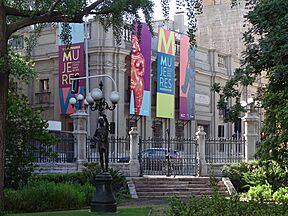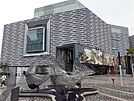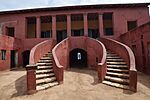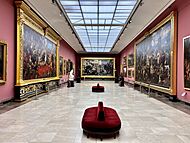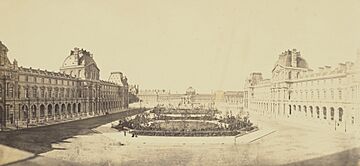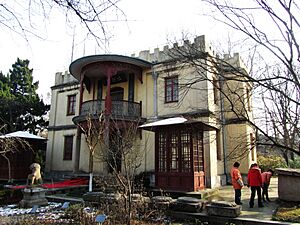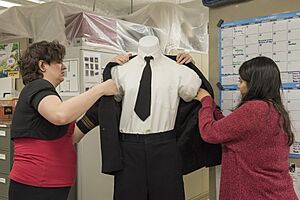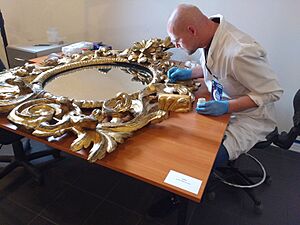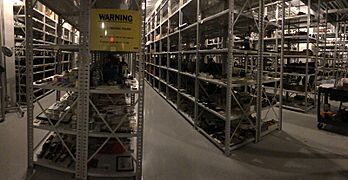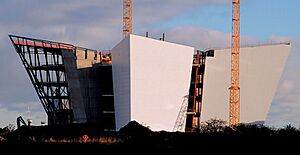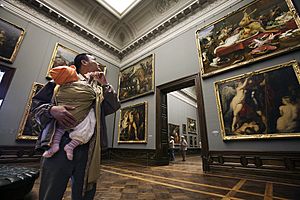Museum facts for kids
Quick facts for kids Museum |
|
|---|---|
|
The Museo Chileno de Arte Precolombino in Santiago, Chile
Grand Egyptian Museum in Cairo, Egypt
The Canada Science and Technology Museum in Ottawa, Canada
The Hong Kong Museum of Art in Tsim Sha Tsui, Hong Kong
The House of Slaves in Gorée, Senegal
Diorama at the Indian Museum in Kolkata, India
Gallery at the Sukiennice Museum in Kraków, Poland
|
A museum is a special place that collects, protects, and shows off important objects. These objects can be about culture, history, or science. Many museums have exhibits that everyone can see. Some also have private collections for researchers.
Museums hold many more kinds of objects than a library. They often focus on one main topic. This could be art, science, natural history, or local history. Public museums with fun exhibits are popular tourist attractions. Millions of people visit the most famous museums each year.
The idea of museums started a long time ago. The earliest known museum was in ancient times. Back then, museums were mostly private collections of interesting items. Later, they became places to teach the public.
Contents
What Does "Museum" Mean?
The word museum comes from Latin. It originally came from the Ancient Greek word mouseion. This word meant a place or temple for the muses. The muses were goddesses of the arts in Greek mythology. So, a mouseion was a building for study and the arts. A famous one was in Alexandria, built around 280 BC.
Why Do We Have Museums?

Museums collect, protect, explain, and display important objects. These objects can be cultural, historical, or scientific. Their main jobs are to save our heritage for the future. They also help educate people through exhibits and programs.
Teaching is a big part of what museums do. They spend a lot of time and money on learning activities. For example, U.S. museums offer millions of hours of tours and workshops every year. Museums also help the economy. They create jobs, bring in tourists, and add tax money.
Each museum has a different mission. Some focus on interactive learning. Others might focus on local history or a specific culture. National museums try to be open to everyone. They choose what to collect based on their mission.
Museums work hard to keep objects safe. They use special storage, like climate-controlled rooms. They also use digital tools to save information. This helps protect artifacts and ensures they are cared for properly.
How Museums Have Changed Over Time
In the 1800s, museums mostly focused on science. They organized collections of natural items. They wanted to classify and study objects found during explorations. These museums were mainly for scholars, but they slowly opened to the public.
In the early 1900s, museums still focused on collecting and studying artifacts. Exhibits were often static, meaning they didn't move or change much. They were mostly for experts. Later in the 1900s, museums started to get less money from the government. This made them focus more on attracting visitors. They began to create more interactive exhibits.
Today, museums want to be open and welcoming to everyone. They use digital tools like virtual tours to reach more people. Museums also talk about important social issues. They want to represent many different communities. While still protecting objects, museums are now places for discussion and social change.
What Do Experts Say a Museum Is?
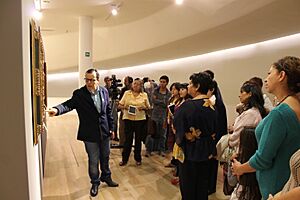
Many groups around the world define what a museum is. They all agree that museums are for the public good. They also agree that museums care for, protect, and explain their collections.
The International Council of Museums says a museum is a non-profit place. It researches, collects, protects, explains, and shows off heritage. It's open to the public, welcoming, and works with communities.
The Canadian Museums Association says a museum is a non-profit place. It conserves, studies, and exhibits objects for public learning and enjoyment.
The United Kingdom's Museums Association says museums help people explore collections. They inspire, teach, and bring joy. They collect and protect artifacts for society.
A Look Back at Museum History
Ancient Museums and Collections
One of the oldest known museums was Ennigaldi-Nanna's museum. Princess Ennigaldi built it in modern Iraq around 530 BC. It held items from older Mesopotamian civilizations. A clay label found there described an item in three languages.
Ancient Greeks and Romans collected art, but their "museums" were different. Temples often housed collections of offerings. Paintings and sculptures were displayed in public places. Libraries and museums were often together, sometimes connected to temples. The Museum of Alexandria was like a library and inspired later museums.
Royal palaces also acted as museums. Rulers displayed art and objects from conquered lands. This showed off their wealth and power to guests. Ptolemy II Philadelphus in Alexandria also had the first zoo. He kept African elephants and other animals like zebras and giraffes for show.
Early Public Museums
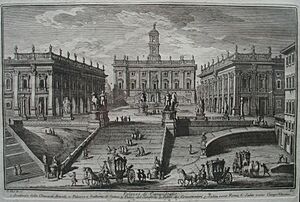
The Capitoline Museums in Rome, Italy, are thought to be the world's oldest public museum. They started in 1471 when Pope Sixtus IV gave ancient bronze sculptures to the people of Rome. These museums officially opened to the public in 1734. This was a big step, letting ordinary people see art, not just the rich.
The Capitoline Museums showed a change in how art was owned and shared. It moved from private hands to public enjoyment. Over time, their collections grew to include Roman statues, Renaissance art, and more.
The Vatican Museums in Vatican City also started early. They began in 1506 when Pope Julius II bought a famous sculpture.
Other early museums started as private collections. Wealthy people collected interesting natural objects and artifacts. These were often shown in "wonder rooms" or cabinets of curiosities. These collections first appeared in Europe.
It was hard for the public to see these private collections. Rich collectors gained status by showing off their finds. They used these displays to organize new discoveries.
One famous collector was Ulisse Aldrovandi. He tried to collect everything he could. But later, people wanted museums to be more organized. Scholars in the 1700s focused on "organization and taxonomy."
When the British Museum opened in 1759, they worried about crowds. Visitors had to apply in writing. Small groups were allowed in each day. But the British Museum became very popular in the 1800s. People of all ages and classes visited.
The Ashmolean Museum in Oxford, England, opened in 1683. It was based on Elias Ashmole's personal collection. It included coins, books, and animal specimens. One famous item was the stuffed body of the last dodo seen in Europe. Sadly, it was destroyed by moths in 1755, except for its head and a claw.
In France, the Louvre in Paris became the first public museum in 1793. It opened during the French Revolution. This meant everyone could see the French royal art collections for free. As Napoléon I conquered cities, he added many art objects. After he was defeated, many items were returned.
Visitors from China and Japan were amazed by European museums. They struggled to find a word for them. Chinese visitors called them "bone amassing buildings" or "courtyards of treasures." Japan used "hakubutsukan," meaning "house of extensive things." This became the word for museum in both countries.
Modern Museums Today
American museums joined European ones as leaders in creating new knowledge. The late 1800s and early 1900s were a time of great museum building. Many American museums wanted to focus on North American discoveries. But they also copied European museums, collecting items from ancient Egypt, ancient Greece, and ancient Rome.
Today, museums still create new knowledge. They also build collections for both research and display.
How Museums Are Managed

How a museum is run depends on its size. A Board and a Director set up rules and policies. These rules guide the museum's actions. They include plans, ethics, and collection policies.
- Board of Trustees or Board of Directors – This group guides the museum. They make sure it's financially and ethically strong. They set policies and often help raise money.
- Executive Director – This person leads the museum. They set goals, manage daily tasks, and oversee staff. They work with the board to get funding and represent the museum to the public.
Many people work together to make a museum run well:
- Curator – Curators look after collections of art or historical objects. They research items, check if they are real, and plan exhibits. They also help create educational programs.
- Collections Manager – These managers care for, document, and move objects. They keep accurate records and update databases. They also pack and store objects safely.
- Registrar – Registrars manage all the paperwork for museum objects. They track items owned by the museum or on loan. They also handle shipping, insurance, and legal documents for loans.
- Educator – Museum educators teach visitors. They design tours and programs for kids and adults. They also create resources for schools and work with communities.
- Exhibit Designer – These designers create the look and feel of exhibits. They plan layouts, lighting, and how items are arranged. They work to make exhibits engaging and easy to understand.
- Conservator – Conservators protect and repair museum objects. They check an item's condition and stop further damage. They might clean, stabilize, or restore damaged artifacts.
Other museum jobs include photographers, librarians, security staff, and gift shop managers. In smaller museums, one person might do many different jobs.
Keeping Collections Safe
Museums protect cultural items from dangers like natural disasters or war. Groups like UNESCO and Blue Shield International work together to prevent damage. They follow international rules to keep cultural property safe. Blue Shield has helped protect museums in places like Egypt, Syria, and Iraq during conflicts.
Gallery – Museum Storage
How Museums Are Planned
Museum planning involves deciding the museum's purpose and designing its space. John Cotton Dana, a museum founder, wrote about this process. He said museums should be planned based on what the community needs.
Dana believed museums should be easy for everyone to reach. He didn't like gloomy buildings far from cities. Today, many museums try to be more accessible and welcoming. They want to include everyone.
One new idea is "open storage." Most museum collections are hidden away to protect them. But open storage lets the public see items not on display. The Brooklyn Museum's Luce Center for American Art does this. This practice is part of a debate about how accessible museum objects should be.
Modern museums often use images, sounds, and interactive exhibits. Creating a museum starts with a plan. This plan includes the museum's vision and what it needs to achieve it.
Some places that tell great stories don't even call themselves museums. The Griffith Observatory in Los Angeles is one example. It has few artifacts but tells strong stories. The United States Holocaust Memorial Museum in Washington, D.C. uses many artifacts in its powerful exhibits.
Every museum is designed in a special way. Each visitor will see its collection differently. This is what makes museums so interesting.
Museums and Money
Cities sometimes use museums to help their economies grow. The Guggenheim Museum Bilbao in Spain is a good example. The government spent about $100 million to build it. This helped renew the city's old port area. The museum attracted over a million visitors in 2015. Most visitors came from outside Spain. This brought more spending and jobs to the city.
Titanic Belfast in Northern Ireland did something similar. It cost about the same as the Guggenheim. In its first year, it had over 800,000 visitors. This helped the region's economy a lot. Museums like The Broad in Los Angeles also boost local business.
Using museums for money can cause debate. Some people protest when public money is used. But if a museum becomes successful, protests often stop. If a museum doesn't attract enough visitors, criticism can continue.
Where Do Museums Get Their Money?
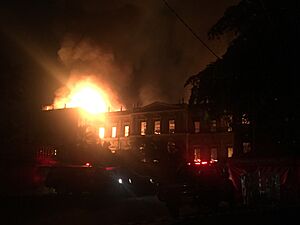
Museums often face money problems. They get funding from four main sources. These are government support, private donations, money they earn (like ticket sales), and investment income. Government funding has decreased for some museums.
Companies can be a good source of money. They currently give about 5% of total funding. This amount was expected to increase in recent years.
Designing Exhibits
Many museums have staff who design exhibits. These teams include designers, architects, and audio-visual experts. They also have writers and people who study visitors. These teams plan how to best share a message or tell a story.
Some experts wonder if museums even need physical objects anymore. Historian Steven Conn suggests that museums have fewer objects now. They are replaced by interactive technology. As educational programs grow, large collections of objects become less important.
This isn't necessarily a bad thing. It means museums can focus on showing key items. Other objects can be stored for students. This is especially true in science museums. Kids visiting these museums might learn more from hands-on tech.
Different Kinds of Museums
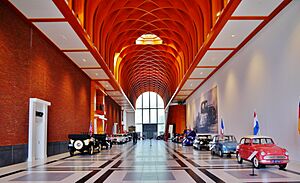
There are many different kinds of museums. They can vary in size, from huge places to small ones. Some focus on a specific location or person. Museums also get money from different sources. These include governments, universities, or private groups.
Some museums show how a topic has changed over time. These are called diachronic museums. An example is the Lower East Side Tenement Museum. Others show a topic at one specific point in time. These are called synchronic museums, like the Anne Frank House.
Author Elaine Heumann Gurian suggests five types of museums based on their goal: object-focused, story-focused, visitor-focused, community-focused, and national.
Museums can also be grouped by what they collect. These include fine arts, applied arts, craft, archaeology, anthropology, history, science, technology, children's museums, and natural history. Many museums specialize even further. For example, they might focus on modern art or military history. Most museums have a "permanent collection" and also show "special collections" for a short time.
Main Types of Museums
Here is a list of some major museum types:
- Agricultural
- Architecture
- Archaeological
- Art
- Automotive
- Design
- Biographical
- Children's
- Community
- Encyclopedic
- Folk
- Historic house
- Historic site
- Living history
- Local
- Maritime
- Medical
- Memorial
- Military
- Natural history
- Open-air
- Science
- Virtual
Public vs. Private Museums
Private museums are started by individuals and run by a board. Public museums are created and managed by governments. This difference affects who owns the collections and who is legally responsible for them.
Non-profit vs. For-profit Museums
A non-profit museum is a charity. It doesn't pay most taxes, and any money it earns goes back into the museum. A for-profit museum pays its earnings to its owners or shareholders. Non-profit museums hold their collections for the public's benefit. For-profit museums own their collections as business assets.
Challenges Museums Face Today
Returning Cultural Items
Many people believe museums should return cultural items to their original homes. This movement is called "decolonization." They argue that museums sometimes tell only one side of a story. They might not show the full history of how an object was taken.
A report in 2018 discussed returning African cultural heritage. This report focused on items taken from African countries. Since 1868, several large Moai statues were taken from Easter Island. They are now in museums like the British Museum. The Rapa Nui see these statues as ancestors. They have asked for them to be returned.
Other examples include the Gweagal Shield and the Elgin Marbles. These items were taken from their original places long ago. Many groups are now asking for these important cultural objects to be returned. There is also a push to show stories of groups that haven't been well-represented in museums.
Returning Human Remains

In the United States, a law called the Native American Graves Protection and Repatriation Act (NAGPRA) helps return human remains. This law, passed in 1990, requires museums to return Native American remains and objects to their descendants. Recent updates to NAGPRA mean museums must get permission before showing or studying these remains.
Many museums are now covering displays and talking more with tribes. They are checking their collections to follow the law. However, there are still challenges. These include incomplete records and finding the right cultural groups.
In Europe, returning human remains also follows new ethical rules. Laws and policies in countries like the UK, Germany, and France guide this process. Museums are encouraged to be open and work with communities. Some museums focus on the scientific value of remains. Others prioritize returning them to their original communities. This process is complex, but there is growing pressure to address past actions.
Museum Workers and Unions
More and more museum workers are joining unions. Over 15,000 museum employees in the U.S. are now part of unions. This includes staff at famous places like the Philadelphia Museum of Art. Workers want fair treatment and better pay. In 2019, many cultural workers shared their salaries online to show pay differences.
The idea of museum workers forming unions isn't new. In 1933, artists in New York formed a union to help unemployed artists. In 1971, staff at New York's Museum of Modern Art formed a union. They wanted better wages and a say in museum decisions. For many years, few other museums followed this trend.
How Unions Form Museum workers usually start by talking about shared concerns. They might then join an existing union or create a new one. They ask museum leaders to recognize their union. If recognized, the union then negotiates a contract. This contract covers wages, benefits, and working conditions.
Union Actions Museum workers have gone on strike to get better wages and conditions. In December 2024, security guards at the Seattle Art Museum went on strike. This led to their first contract and higher pay. Staff at the Massachusetts Museum of Contemporary Art also went on strike in March 2024. They got a new contract with better pay and benefits. Security guards in the UK also went on strike in December 2024 for better pay and sick leave.
Unions also hold protests. In February 2025, Brooklyn Museum workers protested planned layoffs. They said management didn't talk to them first. They wanted other solutions instead of job cuts.
Forming unions can be tough. In 2019, the Marciano Art Foundation closed after workers tried to unionize. But many unions have succeeded. MASS MoCA workers formed their union in 2021 and got a contract in 2024. Science Museum of Minnesota workers also formed a union in 2023 and got their first contract.
Museums and Climate Change
Museums are also responding to climate change. They are using sustainable practices. They also create exhibits that highlight issues about climate change and how humans affect the Earth.
Museums in the Digital Age
As our world becomes more digital, museums are changing too. They are offering more online resources. This includes virtual tours and online collections.
See also
 In Spanish: Museo para niños
In Spanish: Museo para niños
- Audio tour
- Category:Types of museums
- Cell phone tour
- Collective memory
- Computer Interchange of Museum Information
- International Museum Day (18 May)
- List of largest art museums
- List of most visited art museums
- List of most-visited museums by region
- Lists of museums
- .museum
- Museum education
- Museum fatigue
- Museum label
- Museum shop
- Musqueam First Nation
- Science tourism
- Virtual Library museums pages


